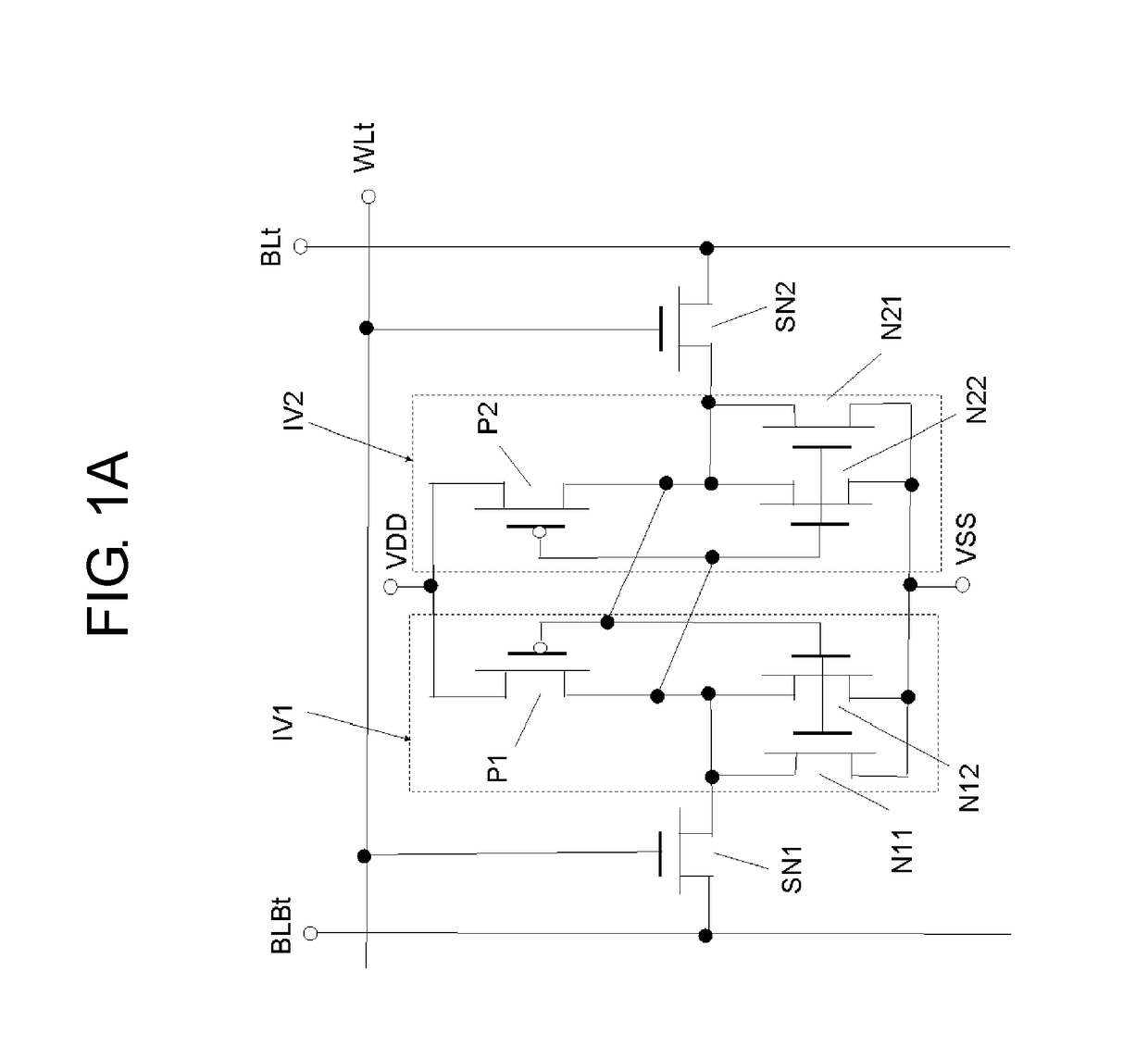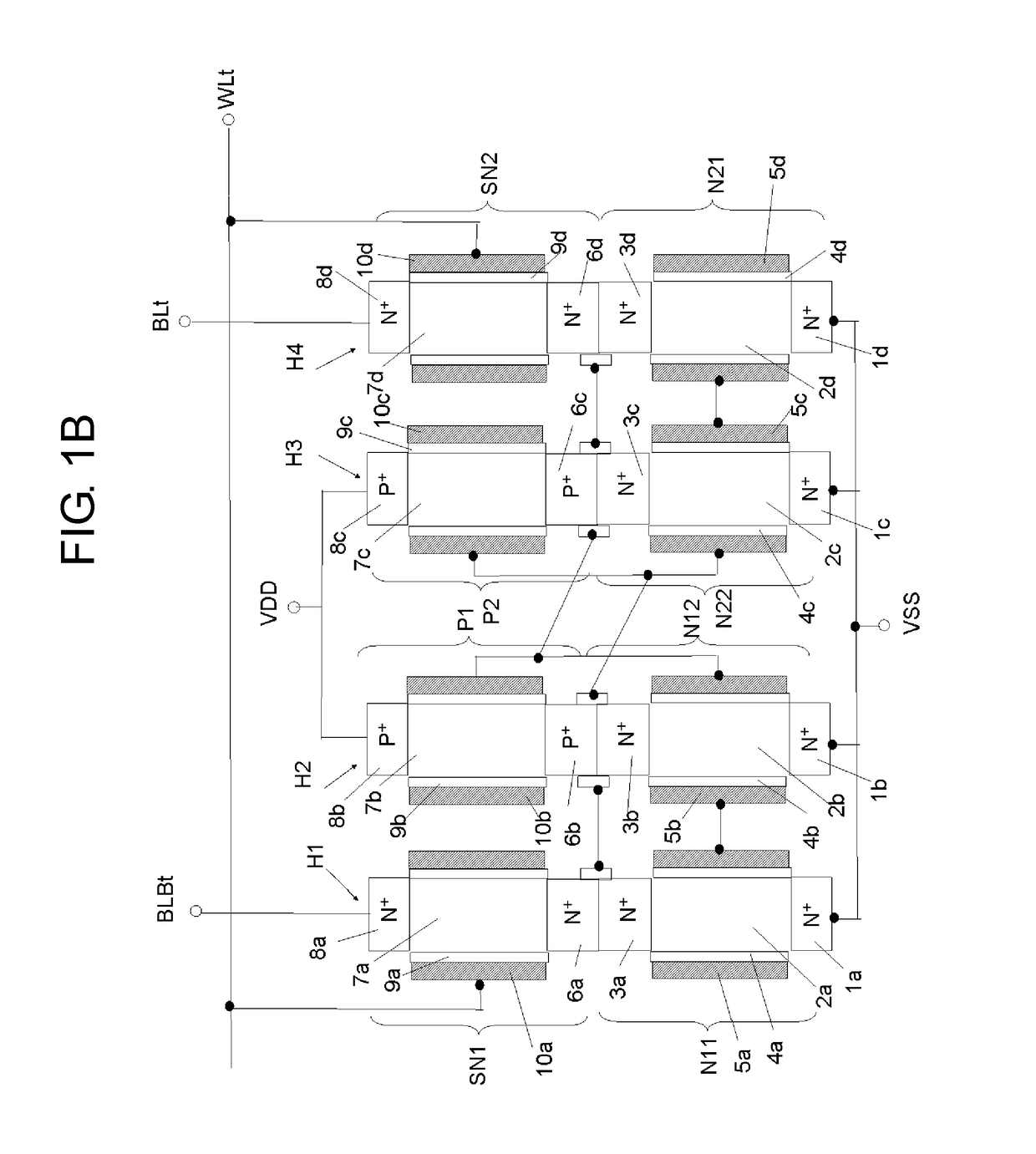Method for producing an sgt-including semiconductor device
a technology of semiconductor devices and semiconductor chips, applied in semiconductor devices, digital storage, instruments, etc., can solve the problems of circuit chip cost reduction, and achieve the effect of high accuracy and high accuracy
- Summary
- Abstract
- Description
- Claims
- Application Information
AI Technical Summary
Benefits of technology
Problems solved by technology
Method used
Image
Examples
first embodiment
[0090]An SGT-including semiconductor device and a production method therefor according to a first embodiment are described below with reference to FIGS. 1A to 1C and 2AA to 2WC.
[0091]FIG. 1A is a circuit diagram of a static random access memory (SRAM) cell circuit according to this embodiment. The SRAM cell includes two inverter circuits IV1 and IV2. The inverter circuit IV1 is constituted by a P-channel SGT P1 serving as a load transistor and two N-channel SGTs N11 and N12 serving as drive transistors and being connected in parallel. The inverter circuit IV2 is constituted by a P-channel SGT P2 serving as a load transistor and two N-channel SGTs N21 and N22 serving as drive transistors and being connected in parallel. The gate of the P-channel SGT P1 of the inverter circuit IV1 is connected to the gates of the N-channel SGTs N11 and N12. The drain of the P-channel SGT P2 of the inverter circuit IV2 is connected to the drains of the N-channel SGTs N21 and N22. The gate of the P-chan...
second embodiment
[0139]A method for producing an SGT-including semiconductor device according to a second embodiment will now be described with reference to FIGS. 3AA to 3FC.
[0140]In the second embodiment, the same steps as those illustrated in FIGS. 2AA to 2JC are performed prior to a step shown in FIGS. 3AA to 3AC. The description therefor is thus omitted. Subsequent to the step shown in FIGS. 2JA to 2JC, resist layers 61a, 61b, 61c, and 61d are formed by applying a resist sensitive to light, an X-ray, or an electron beam and performing lithography, as shown in FIGS. 3AA to 3AC. The resist layer 61a is formed so as to surround the outer periphery of the Si pillar H5. The resist layer 61b is formed so as to come into contact with the Si-pillar-H4-side side wall of the Si pillar H3 and surround the outer periphery of the Si pillar H4. The resist layer 61c is formed so as to come into contact with the side wall of the Si pillar H2 and surround the outer periphery of the Si pillar H1. The resist layer...
third embodiment
[0148]A method for producing an SGT-including semiconductor device according to a third embodiment will now be described with reference to FIGS. 4AA to 4DC. In this embodiment, the technical idea of the present invention is applied to an SGT-CMOS inverter circuit. In FIGS. 4AA to 4DC, a drawing whose reference ends with A is a plan view, a drawing whose reference ends with B is a cross-sectional view taken along line X-X′, and a drawing whose reference ends with C is a cross-sectional view taken along line Y-Y′.
[0149]As illustrated in FIG. 4AA to 4AC, Si pillars H10a and H10b are formed on an i-layer substrate 66. A SiO2 layer 67 is formed around the Si pillars H10a and H10b and on the i-layer substrate 66. Gate insulating layers 68a and 68b are formed on the outer peripheries of the Si pillars H10a and H10b and gate conductor layers 69a and 69b composed of, for example, TiN are formed on the outer peripheries of the gate insulating layers 68a and 68b. A resist layer 70 is formed so...
PUM
 Login to View More
Login to View More Abstract
Description
Claims
Application Information
 Login to View More
Login to View More - R&D
- Intellectual Property
- Life Sciences
- Materials
- Tech Scout
- Unparalleled Data Quality
- Higher Quality Content
- 60% Fewer Hallucinations
Browse by: Latest US Patents, China's latest patents, Technical Efficacy Thesaurus, Application Domain, Technology Topic, Popular Technical Reports.
© 2025 PatSnap. All rights reserved.Legal|Privacy policy|Modern Slavery Act Transparency Statement|Sitemap|About US| Contact US: help@patsnap.com



